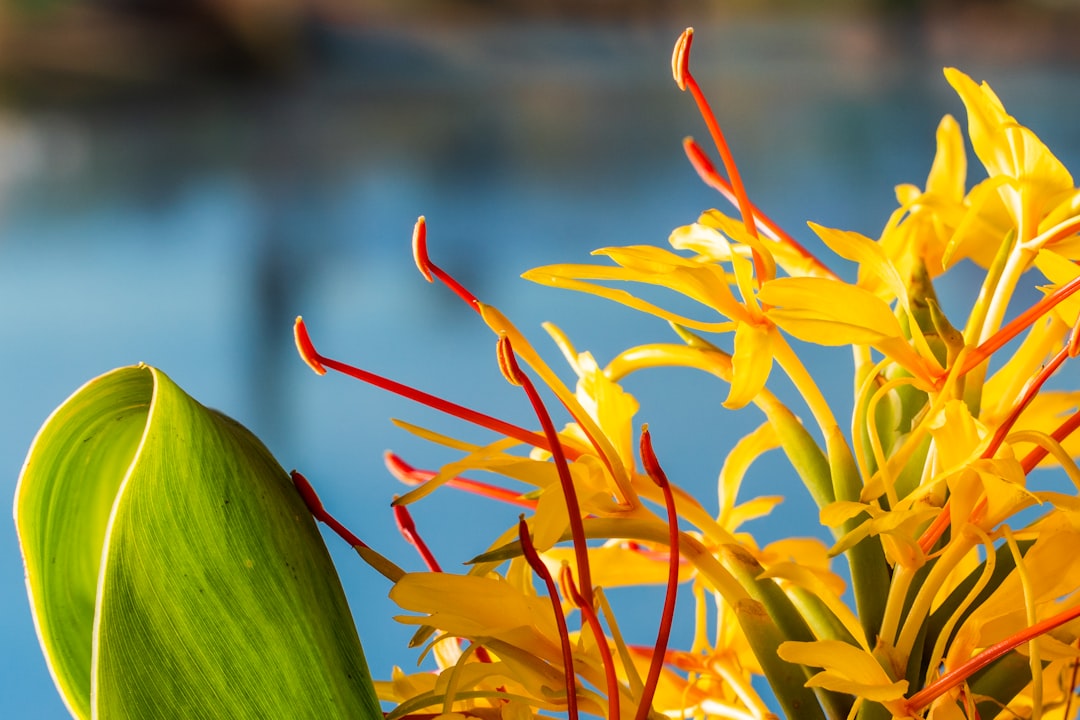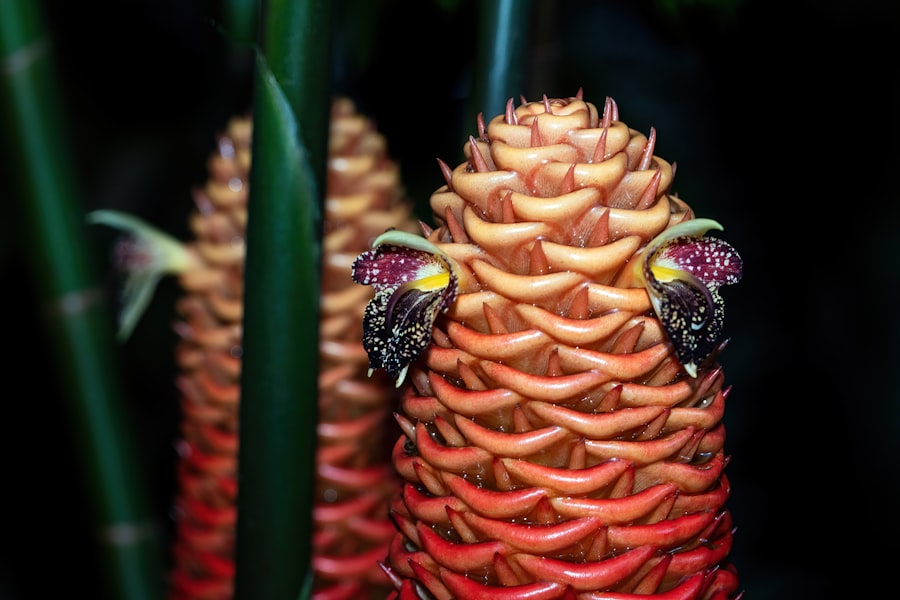Growing Ginger: Tips for a Thriving Plant

Ginger is a versatile and flavorful spice that is used in a variety of dishes and beverages. It has a unique taste that adds a zing to any recipe. In addition to its culinary uses, ginger also has numerous health benefits. It is known for its anti-inflammatory properties and can help with digestion, nausea, and even pain relief. With all these benefits, it’s no wonder that many people are interested in growing ginger at home.
Growing ginger at home has several advantages. First, it allows you to have a fresh supply of ginger whenever you need it. You won’t have to rely on store-bought ginger that may have been sitting on the shelf for weeks or even months. Second, growing your own ginger gives you control over the quality of the spice. You can ensure that it is grown organically and free from any pesticides or chemicals. Finally, growing ginger can be a rewarding and enjoyable experience. It’s a great way to connect with nature and learn about the process of plant growth.
Choosing the Right Ginger Variety
There are several different types of ginger available, each with its own unique characteristics. The most common variety is called Zingiber officinale, which is the type typically found in grocery stores. This variety has a spicy and pungent flavor that is perfect for cooking and baking.
Another popular variety is called Galangal ginger, which has a milder flavor and is often used in Thai cuisine. It has a citrusy and earthy taste that adds depth to curries and soups.
When choosing a ginger variety, there are several factors to consider. First, think about how you plan to use the ginger. If you primarily want to use it for cooking, then Zingiber officinale is a good choice. If you want to experiment with different flavors and cuisines, then Galangal ginger may be more suitable.
Second, consider the climate in your area. Some ginger varieties are more cold-tolerant than others. If you live in a colder climate, look for a variety that can withstand lower temperatures.
Preparing the Soil for Ginger
Ginger plants thrive in loose, well-draining soil. They prefer a slightly acidic pH level of around 6.0 to 6.5. Before planting ginger, it’s important to prepare the soil properly to ensure optimal growth.
Start by clearing the area of any weeds or debris. Ginger plants don’t like competition, so it’s important to remove any potential obstacles. Next, loosen the soil with a garden fork or tiller. This will help improve drainage and allow the ginger roots to penetrate the soil more easily.
Once the soil is loosened, incorporate organic matter such as compost or well-rotted manure. This will help improve the soil structure and provide essential nutrients for the ginger plants. Spread a layer of organic matter over the soil and mix it in thoroughly.
Planting Ginger: Step-by-Step Guide
| Step | Description | Timeframe |
|---|---|---|
| 1 | Choose a suitable location | Before planting season |
| 2 | Prepare the soil | 1-2 weeks before planting |
| 3 | Obtain ginger seed | Before planting season |
| 4 | Plant the ginger | During planting season |
| 5 | Water regularly | Throughout growing season |
| 6 | Fertilize as needed | Throughout growing season |
| 7 | Harvest the ginger | After 8-10 months of growth |
The best time to plant ginger is in the spring, after the last frost has passed. Ginger is a tropical plant and requires warm temperatures to grow successfully.
To plant ginger, start by selecting healthy ginger rhizomes from a reputable source. Look for rhizomes that are firm and plump, with several buds or “eyes” on them. These buds will eventually sprout into new shoots.
Next, prepare a shallow trench in the prepared soil. The trench should be about 2 inches deep and wide enough to accommodate the ginger rhizomes with some space between them.
Place the ginger rhizomes in the trench with the buds facing up. Space them about 8 to 10 inches apart to allow room for growth. Cover the rhizomes with soil, making sure they are completely buried but not too deep.
Water the newly planted ginger thoroughly to settle the soil and provide moisture for the rhizomes. Keep the soil consistently moist but not waterlogged throughout the growing season.
Watering and Fertilizing Ginger
Ginger plants require regular watering to thrive. They prefer moist soil but can’t tolerate standing water. It’s important to strike a balance between keeping the soil moist and avoiding overwatering.
Water the ginger plants deeply once or twice a week, depending on the weather conditions. The goal is to keep the soil evenly moist, but not soggy. Check the soil moisture regularly by sticking your finger about an inch into the soil. If it feels dry, it’s time to water.
In addition to regular watering, ginger plants also benefit from regular fertilization. Use a balanced organic fertilizer that is high in nitrogen to promote healthy leaf growth. Apply the fertilizer according to the package instructions, usually every 4 to 6 weeks during the growing season.
Controlling Pests and Diseases

Like any plant, ginger is susceptible to pests and diseases. Some common pests that can affect ginger plants include aphids, spider mites, and root-knot nematodes. These pests can cause damage to the leaves and roots of the plant, leading to stunted growth and reduced yield.
To control pests, it’s important to monitor your ginger plants regularly for any signs of infestation. If you notice any pests, you can try using natural methods such as spraying the plants with a mixture of water and dish soap or using insecticidal soap.
In addition to pests, ginger plants can also be affected by diseases such as root rot and fungal infections. To prevent these diseases, it’s important to provide proper drainage and avoid overwatering. If you notice any signs of disease, such as yellowing leaves or wilting, take action immediately to prevent further spread.
Harvesting Ginger: When and How
Ginger plants take about 8 to 10 months to reach maturity and be ready for harvest. The signs that ginger is ready for harvest include yellowing leaves and dying back of the foliage. This indicates that the plant has stopped growing and is diverting its energy to the rhizomes.
To harvest ginger, start by carefully digging around the base of the plant with a garden fork or shovel. Be careful not to damage the rhizomes as you dig. Once you have loosened the soil, gently lift the plant out of the ground.
Shake off any excess soil from the rhizomes and cut off the foliage, leaving about an inch of stem attached to each rhizome. This will help prevent moisture loss during storage.
Storing and Using Fresh Ginger
Fresh ginger can be stored in several ways to ensure its longevity. One method is to wrap the ginger in a paper towel and place it in a plastic bag in the refrigerator. This will keep it fresh for up to three weeks.
Another option is to freeze ginger. To do this, peel and grate the ginger, then place it in an airtight container or freezer bag. Frozen ginger can be stored for up to six months and can be used directly from the freezer in recipes.
Fresh ginger can be used in a variety of ways in cooking and home remedies. It adds a spicy kick to stir-fries, soups, and curries. It can also be used to make ginger tea or added to smoothies for an extra boost of flavor.
Propagating Ginger: How to Grow More Plants
If you want to grow more ginger plants, you can propagate them from existing rhizomes. To do this, select healthy rhizomes with several buds or “eyes” on them.
Cut the rhizome into smaller pieces, making sure each piece has at least one bud. Allow the cut pieces to dry for a day or two to prevent rotting.
Next, plant the rhizome pieces in prepared soil, following the same planting instructions as before. Water the newly planted rhizomes and provide them with the same care as mature ginger plants.
Frequently Asked Questions about Growing Ginger
Q: Can I grow ginger indoors?
A: Yes, ginger can be grown indoors as long as it receives enough sunlight and warmth. Place the ginger plant near a sunny window or use grow lights to provide adequate light.
Q: How long does it take for ginger to sprout?
A: Ginger can take anywhere from 2 to 4 weeks to sprout, depending on the growing conditions. Be patient and provide consistent care to encourage sprouting.
Q: Can I grow ginger from store-bought ginger?
A: Yes, you can grow ginger from store-bought rhizomes. However, keep in mind that store-bought ginger may have been treated with growth inhibitors, which can affect its ability to sprout.
Q: Can I grow ginger in containers?
A: Yes, ginger can be grown in containers as long as the container is large enough to accommodate the plant’s root system. Use a well-draining potting mix and provide regular watering and fertilization.
Additional resources for ginger growers:
– “The Complete Book of Ginger: Growing, Harvesting, and Using Ginger for Health and Beauty” by Vicki Engeham
– “Ginger: The Genus Zingiber” edited by P. N. Ravindran
– Online forums and gardening communities where you can connect with other ginger growers and exchange tips and advice.
Growing ginger at home is a rewarding and enjoyable experience that allows you to have a fresh supply of this versatile spice whenever you need it. By choosing the right variety, preparing the soil properly, and providing proper care, you can successfully grow ginger in your own backyard or even indoors. Whether you use it in cooking or for its health benefits, growing ginger at home is a great way to connect with nature and enhance your culinary creations. So why not give it a try and start growing your own ginger today?



